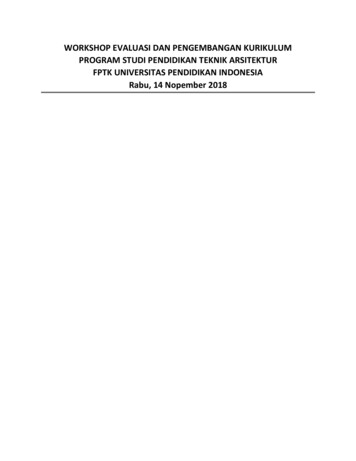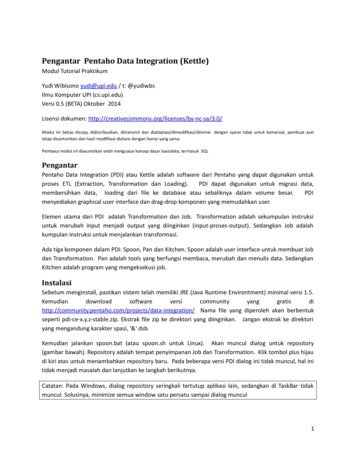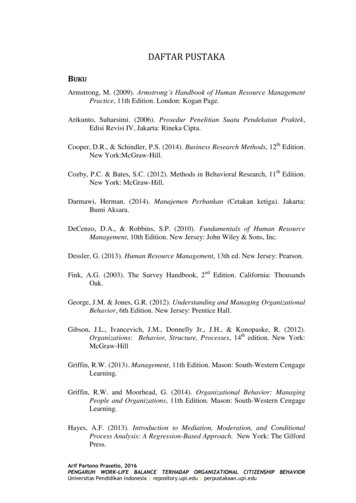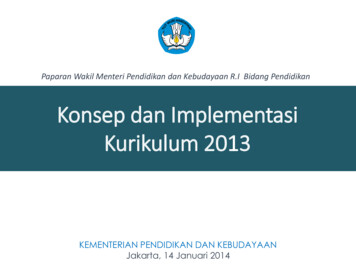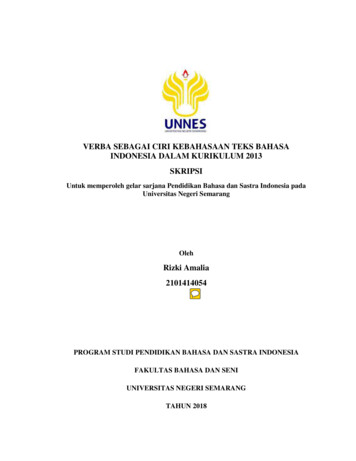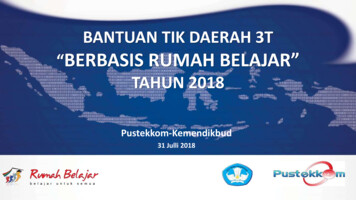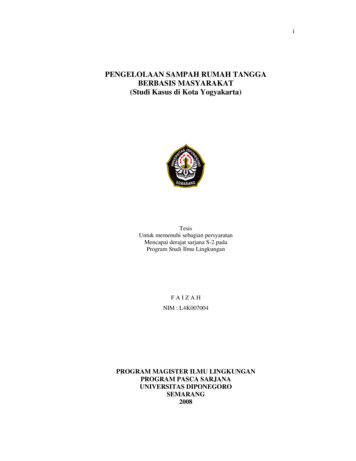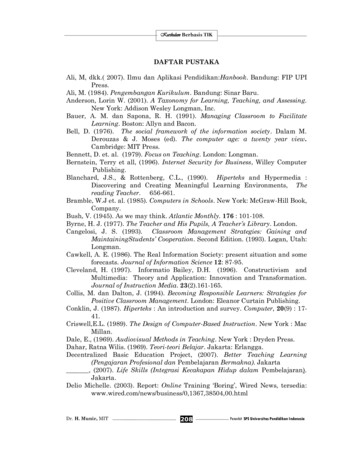
Transcription
Kurikulum Berbasis TIKDAFTAR PUSTAKAAli, M, dkk.( 2007). Ilmu dan Aplikasi Pendidikan:Hanbook. Bandung: FIP UPIPress.Ali, M. (1984). Pengembangan Kurikulum. Bandung: Sinar Baru.Anderson, Lorin W. (2001). A Taxonomy for Learning, Teaching, and Assessing.New York: Addison Wesley Longman, Inc.Bauer, A. M. dan Sapona, R. H. (1991). Managing Classroom to FacilitateLearning. Boston: Allyn and Bacon.Bell, D. (1976). The social framework of the information society. Dalam M.Derouzas & J. Moses (ed). The computer age: a twenty year view.Cambridge: MIT Press.Bennett, D. et. al. (1979). Focus on Teaching. London: Longman.Bernstein, Terry et all, (1996). Internet Security for Business, Willey ComputerPublishing.Blanchard, J.S., & Rottenberg, C.L., (1990). Hiperteks and Hypermedia :Discovering and Creating Meaningful Learning Environments, Thereading Teacher. 656-661.Bramble, W.J et. al. (1985). Computers in Schools. New York: McGraw-Hill Book,Company.Bush, V. (1945). As we may think. Atlantic Monthly. 176 : 101-108.Byrne, H. J. (1977). The Teacher and His Pupils, A Teacher‟s Library. London.Cangelosi, J. S. (1993). Classroom Management Strategies: Gaining andMaintainingStudents‟ Cooperation. Second Edition. (1993). Logan, Utah:Longman.Cawkell, A. E. (1986). The Real Information Society: present situation and someforecasts. Journal of Information Science 12: 87-95.Cleveland, H. (1997). Informatio Bailey, D.H. (1996). Constructivism andMultimedia: Theory and Application: Innovation and Transformation.Journal of Instruction Media. 23(2).161-165.Collis, M. dan Dalton, J. (1994). Becoming Responsible Learners: Strategies forPositive Classroom Management. London: Eleanor Curtain Publishing.Conklin, J. (1987). Hiperteks : An introduction and survey. Computer, 20(9) : 1741.Criswell,E.L. (1989). The Design of Computer-Based Instruction. New York : MacMillan.Dale, E., (1969). Audiovisual Methods in Teaching. New York : Dryden Press.Dahar, Ratna Wilis. (1969). Teori-teori Belajar. Jakarta: Erlangga.Decentralized Basic Education Project, (2007). Better Teaching Learning(Pengajaran Profesional dan Pembelajaran Bermakna). Jakarta, (2007). Life Skills (Integrasi Kecakapan Hidup dalam Pembelajaran).Jakarta.Delio Michelle. (2003). Report: Online Training „Boring‟, Wired News, 00.htmlDr. H. Munir, MIT208Penerbit SPS Universitas Pendidikan Indonesia
Kurikulum Berbasis TIKDempsey. John , Reiser Robert A. (2002). Trends and Issues in InstructionalDesign and Technology. Ohio: Merril Prentice HallDepartemen Pendidikan Nasional, (2006). Kurikulum Tingkat SatuanPendidikan. Jakarta: Depdiknas., (2004). Kurikulum Berbasis Kompetensi. Jakarta: Depdiknas.Denham,C. & Lieberman,A. (1980). Time to Learn. Washington,DC : USGovernment Printing Office.DePorter,B., (1992). Quantum Learning : Unleashing the Genius in You. NewYork: Dell Pub.Co.DeVoogd, G. & Kritt, D. (1997). Komputer-Mediated Instruction For YoungChildren: Teacher and Software Missing the Zone. Proceeding of SITE97. Tersedia: http://www.coe.uh.edu/insite/elec pub/HTML1997[1998,November 18].Dordick, H. S. & Wang, G. (1993). The Information Society: a Retrospective View.London: Sage.Dublin , Dublin, L. and Cross, J. (2003) , Implementing eLearning: Getting theMost From Your Elearning Investment. The ASTD InternationalConference.Dublin, P., Pressman, H., Barnett, E., & Woldman, E.J. (1994). IntegratingComputers in Your Classroom : early childhood. New York: HarperCollins Collage Publishers.Elkind,D. (1987). The Child Yesterday, To Day, and Tomorrow. Young Children,42(4), 6-11.Feldman, T., (1995). Multimedia. New York : Blueprint.Furht, B., (1996). FAU Computer Science & Engineering Multimedia System.Florida: Atlantic University.Gagne, R.M. (1971). The Learning Theory, Education Media, And IndividualizedInstruction. In. Tickton S.(ed) To Improve Learning an Evaluation ofInstructional. Technology. London:. Bowker Co.Gagne, R.M. (1977). The Conditions of Learning. Third Edision New York :Holt,Rinerhart and Winston.Geisert, P. dan Futrell, M. (1990). Teachers, Computers and Curriculum:Microcomputers in the Classroom. Boston: Allyn and Bacon.Hadvind, R. (1990). Hiperteks : The Smart Tool for Information Overload.Technology Review ( November/December) : 42-50.Halimah Badioze Zaman dan Munir. (1998). Model Pakej Multimedia dalamPendidikan (MEL): Literasi dan Model Pendekatan Kesusasteraan:Bercerita dalam Perkembangan Literasi. Malaysia: IRPA 04-02-02-0008.Hammond, N. (1993). Learning with Hiperteks : Problems, Principles andProspectus. In C.McKnight, A.Dillon and J.Richardson (eds) Hypertext aPsychological Perspective. New York: Ellis Horwwod.Haugland, S.W. & Wright, J.L. (In press). Young Children and Computers.Washington D.C.: National Association for the Education of YoungChildren.Dr. H. Munir, MIT209Penerbit SPS Universitas Pendidikan Indonesia
Kurikulum Berbasis TIKHadiana, A, Kenji Kaijiri, (2003), Collaboration Learning Support SystemUsing Q&A. 4th International Conference of Information Technologyfor High Education and Training.Hyper Studio. (1995). Computer Software. El Cajon, CA : Roger WagnerPublishing.Ismail, T. (1999). Budaya Baca Harus Dimulai dari Cerita Anak-anak. KertasKerja Seminar Kebahasaan. Malang: Sidang ke-38 MABBIMJacobs, G. (1992). An Interactive Learning Revolution ? The CTTSS File.October 3(5):3-5Japanese Association of Education Engineering, Dictionary of EducationEngineering. Jikkyou PublisherJohnson D. W., Johson R. T., and Smith K. (1991). Active Learning:Cooperation in the Classroom. Edina, MN: Interaction BookCompany.Johson D. W. Learning Together and Alone. Englewood Cliffs, NJ:Prentice Hall.Jonassen, D. (1990). Semantic Network Elicitation : Tools for StructuringHiperteks. In R. McAleese (ed) Hypertext State:State of the Art. Oxford:Intellect.Jonassen, D. & Wang S. (1993). Acquiring Structural Knowledge fromSemantically Structured Hiperteks. Journal of Computer-BaseInstruction. 20(1),1-8.Kamus Dewan. (1997). Edisi Ketiga. Kuala Lumpur: Dewan Bahasa danPustaka.Kadir, A. (2003). Pengembangan E-Learning. Tugas Akhir, Jurusan PendidikanMatematika, Universitas Pendidikan IndonesiaKerka, S., &Wonacott, M.E. (2000). Assessing Learners Online : PractitionerFile. Colombus : Ohio State University ERIC Clearing House on Adult,Career, and Vocational Education Center on Education and Training forEmployment.Kibby, M. (1999). Assessing Student Online. The University of New Castle.Tersedia: tmKulik, J.A., Kulik, C.C. & Cohan, P.A. (1980). Effectiveness of Komputer-BasedCollege Teaching : A Meta-Analysis of Findings. Review of EducationalResearch. 50 (4) : 525-544.Kulik, J.A., Bangert, R.L., & Williams, G.w. (1983). Effects of Komputer-BasedTeaching On Secondary School Students. Journal of EducationalPsychology. 75(1) : 19-26.Hartley Darin E. (2001). Selling e-Learning, American Society for Training andDevelopment.Dr. H. Munir, MIT210Penerbit SPS Universitas Pendidikan Indonesia
Kurikulum Berbasis TIKLanza, A. & Roselli, T. (1991). Effects of the Hiperteksual Approach Versus theStructured Approach on Student‟s Achievement. Journal of ComputerBased Instruction. Vol.18(2):48-50.Laurillard, D. (1987). Komputers and Emancipation of Students : Giving Controlto the Learner. Instructional Science. 16 : 3-18.Laurillard, D. (1993). Rethinking University Teaching : A Frame for the EffectiveUse of Educational Technology. London : Routledge.Lemlech, J. K. (1979). Classroom Management. New York: Harper & RowPublishers.Lilley, Peter, (2002). Hacked, Attacked & Abused, Digital Crime Exposed, Koganpage.Machlup, F. (1972). The Production and Distribution of Knowledge in the UnitedStates. Princeton: Princeton University Press.Machlup, F. (1980). Knowledge: Its Creation, Distribution and EconomicSignificance. Princeton: Princeton University Press.Magidson, E.M. (1978). Issue Overview : Trends in Komputer AssistedInstruction. Education Technology. 18(4) : 5.Marion A. Barfurth,. Understanding the Collaborative LearningProcess in a Technology Rich Environment: The Case of Children‟sDiagreements. Departmetn of Science and Education, University ofQuebeca Hull.Masuda, Y. (1981). The Information Society as Post-Industrial Society. Tokyo:Institute for the Information Society.Mathis,A., Smith, T., & Hansen, D. (1970). College Students Attitudes TowardKomputer Assisted Instruction. Journal of Educational Psychology.6l(1) : 46-51.Mayes,T. Kibby,M. & Anderson,T. (1990). Signposts for Conceptual Orientation:Some Requirements for Learning From Hiperteks. In McAleese (ed)Hypertext : State of the Art. Oxford : IntellectMegarry, J. (1988). Hiperteks and Compact Discs : the Challenge of Multi-MediaLearning. British Journal of Educational Technology. 19(3):172-183.Meyen, E.L. (2000). Using Technology to Move Research to Practise: The OnlineAcademmy. Their World (2000). New York: National Centre forLearning Disabilities.Miarso, Yusufhadi, dkk. (1987). Teknologi Komunikasi Pendidikan. Jakarta:Pustekkom Dikbud dan CV Rajawali.Munir. (1997). Package on Encouraging Reading Using Multimedia. Thesis :Master of Information Technology.Bangi, Malaysia: NationalUniversity of Malaysia.Munir. (1998). Pengajaran Membaca bagi Anak-anak melalui BahasaMenyeluruh. Jurnal Dewan Bahasa 42:2 Kuala Lumpur.Munir & Halimah Badioze Zaman. (1998). Menggalakan Anak-anak BelajarMembaca Berbantukan Multimedia. Jurnal Dewan Bahasa 42:12.Kuala Lumpur: Dewan Bahasa dan Pustaka.Dr. H. Munir, MIT211Penerbit SPS Universitas Pendidikan Indonesia
Kurikulum Berbasis TIKMunir & Halimah Badioze Zaman. (1998). “MEL : Meningkatkan KreativitasBerbahasa bagi Anak-anak Prasekolah. Jurnal Dewan Bahasa 43:4Kuala Lumpur : Dewan Bahasa dan Pustaka.Munir. (1989). Pemanfaatan Teknologi Informasi dalam Menghadapi PasarGlobal. Kuliah Umum Magister Manajemen. Palembang: UniversitasSriwijaya.Munir dan Halimah Badioze Zaman. (1999). MEL: Meningkatkan KreativitiBerbahasa bagi Kanak-Kanak Prasekolah Berbantukan Multimedia,Jurnal Dewan Bahasa, 43(4): 320-326. Kuala Lumpur: Dewan Bahasadan Pustaka.Munir dan Halimah Badioze Zaman. (1999). Aplikasi Multimedia dalam ProsesBelajar Mengajar di Perguruan Tinggi. Workshop on ComputerApplication for Management Course. Palembang: Universitas Sriwijaya.Munir. (1999). Pemanfaatan Teknologi Informasi dalam Menghadapi PasarGlobal.Kuliah umum dosen tamu di Magister Managemen.Palembang: Universitas SriwijayaMunir & Halimah Badioze Zaman. (1999). Aplikasi Multimedia dalamPendidikan untuk Memotivasikan Literasi. Jurnal Bahagian TeknologiPendidikan. Bil.1(1999). Kuala Lumpur: Kementerian PendidikanMalaysia.Munir & Halimah Badioze Zaman. (2000). Aplikasi Multimedia dalamPendidikan, Jurnal Pemikir: Januari-Maret (2000). Kuala Lumpur.Munir. (2001). E-Commerce: Model Toko Melalui Internet. Jurnal Strategic. VolI (1). Bandung : UPI Press.Munir. (2001). Aplikasi Multimedia dalam Proses Belajar Mengajar. MimbarPendidikan XX(3). Bandung : UPI Press.Munir & Halimah Badioze Zaman. (2002). Metodologi PengembanganMultimedia dalam Pendidikan. Mimbar Pendidikan XX1(2). Bandung :UPI Press.Munir. (2003). Penggunaan Teknologi Multimedia Terhadap Motivasi BelajarAnak-anak Prasekolah dalam Pembelajaran Literasi. MimbarPendidikan XXII(3). Bandung : UPI Press.Munir. (2004). E-Learning Membangun Sistem Pendidikan Berbasis DuniaMaya. Mimbar Pendidikan XXIII(3). Bandung : UPI Press.Munir. (2004). Pengaruh Efisiensi dan Efektifitas Sistem Teknologi InformasiTerhadap Peningkatan Daya Saing Perusahaan Software House. JurnalManajemen dan Sistem Informasi Vol.2 (4).Munir. (2004). Strategi pengembangan B2B E-Commerce. Jurnal Manajemendan Sistem Informasi Vol.3 (5).Munir. (2005). Manajemen Kelas Berbasis Teknologi Informasi dan Komunikasi.Mimbar Pendidikan XXIV(2). Bandung : UPI Press.Munir. (2005). E-learning. Nuansa Informatika Vol.I(1). Kuningan: UniKu.Munir. (2006). Etika Penggunaan Teknologi Informasi dan Komunikasi dalamPendidikan. Mimbar Pendidikan(2). Bandung : UPI Press.Dr. H. Munir, MIT212Penerbit SPS Universitas Pendidikan Indonesia
Kurikulum Berbasis TIKMunir. (2006). The Effectiveness of Multimedia in Education Package toMotivate Literacy (MEL) among Preschool Children. COMPARE I(2).Journal of the Comparative Educational Society of Asia.Oldcorn, R. (1988). Management: Skills and Functions. London: Pan Books Ltd.Poedjiadi, Anna. Sains Teknologi Masyarakat. Bandung: PPsUPI dan PTRemaja Rosdakarya.Porat, M & Rubin, M. (1977). The Information Economy: Development andMeasurement. Washington, D.C.: Government Printing Office.Porter, Lynnette R. (2003). Developing an On-line Curriculum. Singapore:Information Science PublishingPosamentier, A. S dan Stepelman. J. (1981). Teaching Secondary SchoolMathematics: Techniques and Enrichment Units. Columbus: Charles E.Merrill Publishing Company.Pusat Pengkajian dan Penerapan Teknologi Informasi dan Elektronika. (2001).Indikator Teknologi Informasi dan Komunikasi.Romiszowski, A.J. (1993). Developing Interactive Multimedia Courseware andNetworks : some current. Latchem, J.W. & Henderson-Lancett, L.(1994). Interactive Multimedia: Practice and Promise. 57-78. London:Kogan Page.Robiah Sidin. (1993). Classroom Management. Kuala Lumpur: Fajar Bakti.Rosa, Prima, P.H., dkk. (2008). Makalah-Makalah Sistem Informasi. Bandung:Informatika.Setiawan, W. & Munir. (2006). Pengantar Teknologi Informasi dan Komunikasi.Bandung: UPI Press.Setiyadi, Mas Wigrantoro Roes. (2004). Catatan kuliah Cyber Ethics and Law.M.Kom. Universitas Budi LuhurSeyer, P. (1991). Understanding Hypertext: Concept and Application. New York:Wincrest Books.Solomon, G. (1979). Interaction of Media, Cognition and Learning. SanFrancisco: Jossey-Bass.Spiro R.J.& Jehng,J.C. (1990). Cognitive Flexibility and Hiperteks : Theory andTecnology for the Nonlinear and Multidimensional Traversal of ComplexSubject Matter. In D Nix & R.Spiro (eds) Cognition, Education,Multimedia. London: Lawrence Erlbaum Associates.Stratfold, M.P. (1994). Investigation into the Design of Educational Multimedia :Video, Interactivity and Narrative. Tesis Ph.D. Milton Keynes: OpenUniversity.Taylor, J. & Laurillard,D. (1994). Supporting Resource Based Learning. THD204Reader Article. Milton Keynes : The Open UniversityThompson, S.A. (l994). UpGrading Your PC to Multimedia. Indianapolis: QUECorporation.Trelease, J. (1989). The Read-Aloud Handbook. New York: Penguin Books.Webb,N.L (1992). Assessment of Student Knowledge of Mathematics: StepToward a Theory. University of Wisconsin Madison.Dr. H. Munir, MIT213Penerbit SPS Universitas Pendidikan Indonesia
Kurikulum Berbasis TIKWiggins, G. (1998). Educative Assessment: Designing Assessments to Reform andImprove Group Performance. San Francisco: Jossey Bass.----------, Undang – Undang Perlindungan Terhadap Kekayaan Intelektual,meliputi: UU RI Nomor 14/2001 tentang Paten, UU RI Nomor 15/2001tentang Merek, dan UU RI Nomor 19/2002 tentang Hak Cipta.----------, Inpres 6/2001 tentang Pedoman Pendaya-gunaan dan PemanfaatanTelematika----------, Inpres 3/2003 tentang Pedoman dan Strategi Nasional ElectronicGovernmentDr. H. Munir, MIT214Penerbit SPS Universitas Pendidikan Indonesia
Kurikulum Berbasis TIK Dr. H. Munir, MIT 210 Penerbit SPS Universitas Pendidikan Indonesia Hadiana, A, Kenji Kaijiri, (2003), Collaboration Learning Support System Using Q&A. 4th International Conference of Information Technology for High Education and Training. Hyper Studio. (1995). Computer Software.El Cajon, CA : Roger Wagner
